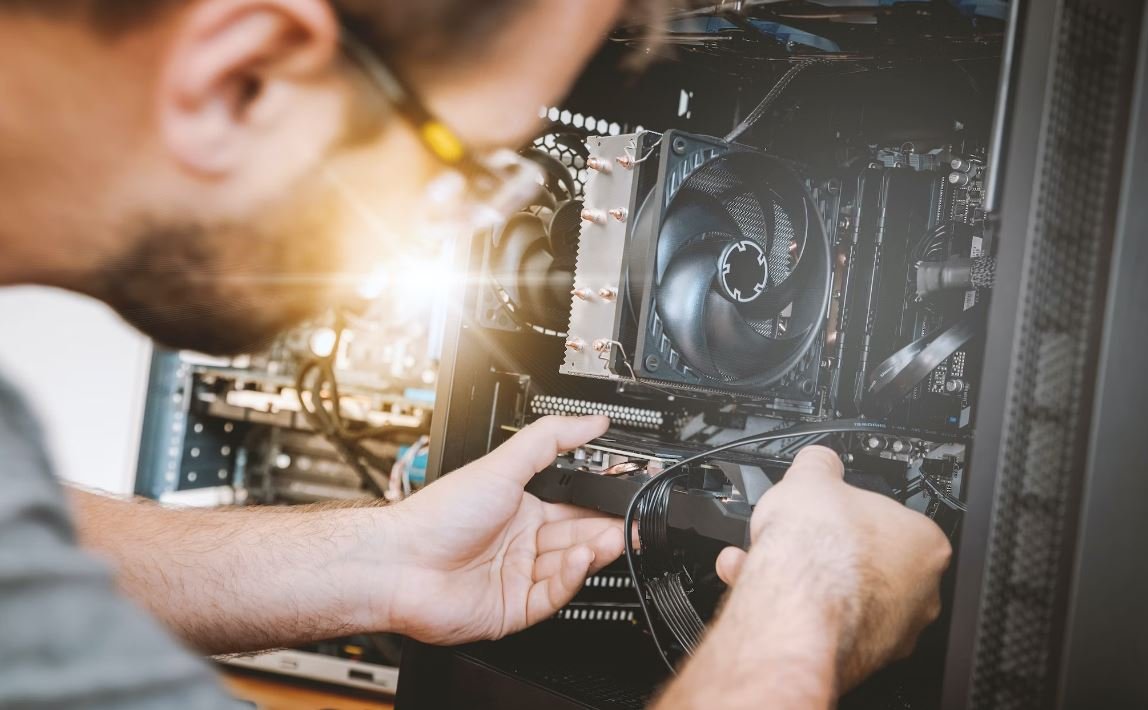What Is Models of Communication?
Communication is an integral part of human interaction, and understanding the process behind it can greatly improve our ability to effectively convey messages. One way to analyze communication is through the use of models of communication, which provide frameworks for understanding how messages are sent, received, and interpreted. In this article, we will explore the various models of communication and their significance in different contexts.
Key Takeaways:
- Models of communication are frameworks used to understand the process of communication.
- These models help us analyze how messages are sent, received, and interpreted.
- Effective communication involves the simultaneous consideration of factors such as sender, receiver, channel, feedback, and noise.
Communication models provide a structured way to comprehend human interaction and improve our communication skills.
The Linear Model of Communication
The linear model of communication is the most basic and straightforward model. It portrays communication as a one-way process, starting from the sender and ending with the receiver. In this model, the sender sends a message through a chosen channel, such as speech or writing, and the receiver receives and interprets the message. Feedback is not considered in this model, and communication is seen as a simple transmission of information.
While simplistic, the linear model of communication can help understand simple forms of communication.
Some key characteristics of the linear model of communication include:
- Sender: The one who initiates and sends the message.
- Message: The information or content being conveyed.
- Channel: The medium used to transmit the message, such as verbal or written communication.
- Receiver: The individual or group who receives the message.
The Interactive Model of Communication
The interactive model of communication expands upon the linear model by incorporating elements of feedback and noise. In this model, communication is seen as a dynamic interaction where both the sender and receiver contribute to the process. Feedback, which can be verbal or non-verbal, allows the receiver to respond to the sender’s message, providing clarification or seeking additional information. Noise refers to any distractions or barriers that may interfere with the communication process, such as background noise or language barriers.
The interactive model of communication recognizes that effective communication is a two-way process involving both the sender and the receiver.
In the interactive model of communication, additional factors come into play:
- Feedback: The response or reaction of the receiver to the sender’s message.
- Noise: Any interference or distractions that may hinder the communication process.
The Transactional Model of Communication
The transactional model of communication builds upon the interactive model by considering communication as a simultaneous exchange of messages between the sender and receiver. In this model, both the sender and receiver take on the role of sender and receiver simultaneously, creating a continuous loop of communication. Each person’s message affects the other, resulting in a mutually influential exchange. This model also takes into account the influence of the environment on communication, recognizing that environmental factors can impact the interpretation of messages.
The transactional model of communication emphasizes the importance of context and mutual influence in the communication process.
Some key aspects of the transactional model of communication include:
- Simultaneous Encoding and Decoding: Both the sender and receiver encode and decode messages simultaneously.
- Environment: The physical, social, and psychological factors that influence communication.
The Importance of Models of Communication
Models of communication provide valuable frameworks for understanding and analyzing the complexities of communication. They help us recognize the various factors at play, such as sender, receiver, message, channel, feedback, noise, and environment. Understanding these models can enhance our communication skills by allowing us to be more aware of the intricacies involved in the interpretation and transmission of messages.
By utilizing models of communication, we can enhance our understanding of the communication process and improve our ability to effectively convey messages.
Overall, models of communication offer valuable insights into the intricate nature of human interaction. They remind us that effective communication goes beyond the mere transmission of information and involves active listening, feedback, and an understanding of the context in which communication takes place.
| Model | Characteristics |
|---|---|
| Linear Model | One-way communication without feedback. |
| Interactive Model | Two-way communication with feedback and noise consideration. |
| Transactional Model | Simultaneous exchange of messages between sender and receiver. |
Conclusion
Understanding models of communication provides a framework for analyzing and improving our communication skills. The linear, interactive, and transactional models of communication each offer valuable insights into different aspects of the communication process. By considering factors such as sender, receiver, message, feedback, noise, and environment, we can become more effective communicators. So, let us embrace these models to enhance our understanding of communication and foster meaningful connections.
| Enhanced communication skills | Improved interpretation and transmission of messages |
|---|---|
| Awareness of factors affecting communication | Increased ability to recognize and overcome barriers |

Common Misconceptions
Misconception 1: Models of Communication are Linear
One common misconception is that models of communication are strictly linear in nature. Many people believe that communication follows a simplistic one-way flow from sender to receiver. However, models of communication are more dynamic and complex than this oversimplified view.
- Communication involves feedback loops
- Interference can occur at any stage of the communication process
- Communication does not always start with a sender and end with a receiver
Misconception 2: Models of Communication are Universally Applicable
Another misconception is that models of communication can be applied universally to every situation. While models of communication provide valuable frameworks for understanding the process, they may not account for cultural, social, or contextual differences that can significantly impact communication.
- Cultural norms influence communication patterns
- Communication models evolve over time
- The context of communication can shape the effectiveness of a model
Misconception 3: Models of Communication are Strictly Verbal
Some people mistakenly assume that models of communication exclusively involve verbal communication. However, communication is a multi-faceted process that encompasses verbal and non-verbal elements. Models of communication recognize the importance of non-verbal cues, such as body language, facial expressions, and tone of voice.
- Non-verbal communication can convey more meaning than words alone
- Different cultures have different non-verbal communication patterns
- Non-verbal cues can sometimes contradict verbal messages
Misconception 4: Models of Communication are Predictive
Another misconception is that models of communication can accurately predict the outcomes of communication exchanges. While models can provide insights into communication patterns, they do not guarantee certain outcomes and cannot account for all variables that may affect the communication process.
- Contextual factors can influence communication outcomes
- Individual interpretation plays a role in communication
- Models cannot account for unpredictable external events
Misconception 5: Models of Communication are Linear
Finally, it is important to dispel the misconception that communication models are static and unchanging. Models of communication evolve over time to reflect the complexities of human interaction and technological advancements. As society changes and new communication channels emerge, models of communication must adapt to accommodate these developments.
- New technologies impact the way we communicate
- Models need to encompass diverse communication channels
- Communication models are constantly influenced by societal shifts

The Process of Communication
Communication is a fundamental aspect of human interaction. In order to understand how communication occurs, various models of communication have been developed. These models depict the process of communication and highlight different elements involved. The following table elaborates on different models of communication:
| Model Name | Description | Advantages | Disadvantages |
|---|---|---|---|
| Linear Model | One-way flow of information from sender to receiver. | Simplicity and ease of understanding. | Lack of feedback and interaction. |
| Interactive Model | Includes feedback from the receiver, allowing for dialogue. | Encourages active participation and clarification. | Assumes a limited number of participants. |
| Transaction Model | Views communication as simultaneous and continuous. | Recognizes the mutual influence between sender and receiver. | Complexity may make it harder to analyze. |
| Strategic Model | Emphasizes the influence and power dynamics within communication. | Helps understand persuasion techniques and manipulative behavior. | May oversimplify the multidimensionality of communication. |
Elements of Effective Communication
In addition to models of communication, certain elements contribute to effective communication. These elements, which are essential to ensuring clear and meaningful exchanges, are illustrated in the table below:
| Element | Description | Importance |
|---|---|---|
| Clarity | Messages should be easily understandable and unambiguous. | Avoids misunderstandings and promotes effective comprehension. |
| Conciseness | Communication should be brief, focused, and to the point. | Prevents information overload and maximizes attention. |
| Active Listening | Engaging attentively with the speaker and providing feedback. | Enhances understanding and strengthens relationships. |
| Nonverbal Cues | Gestures, facial expressions, and body language convey additional meaning. | Helps supplement and reinforce verbal communication. |
The Role of Technology in Communication
Technology has significantly influenced the way we communicate. The following table explores different technological advancements and their impact on communication:
| Technology | Description | Advantages | Disadvantages |
|---|---|---|---|
| Internet | Global network facilitating instant information exchange. | Enables long-distance communication and access to vast resources. | Privacy concerns and potential for information overload. |
| Smartphones | Mobile devices with multiple communication functionalities. | Ubiquitous access to communication channels and applications. | Potential for distraction and dependency. |
| Video Conferencing | Real-time visual and audio communication between remote individuals. | Fosters virtual collaboration and reduces travel expenses. | Reliance on stable internet connections for quality communication. |
| Social Media | Online platforms for sharing content and interacting with others. | Enhanced connectivity, information sharing, and community building. | Potential for misuse, cyberbullying, and false information dissemination. |
Barriers to Effective Communication
Despite our best efforts, various barriers can hinder effective communication. The following table sheds light on some common barriers along with their implications:
| Barrier | Description | Implications |
|---|---|---|
| Language Differences | Communication across different languages or dialects. | Misinterpretation, confusion, and potential misunderstandings. |
| Cultural Differences | Divergent cultural norms, values, and communication styles. | Stereotyping, miscommunication, and strained relationships. |
| Noise | External or internal distractions that hinder message reception. | Incomplete understanding and misinterpretation of information. |
| Emotional Barriers | Emotional states that impact receptivity and understanding. | Conflict, defensiveness, and potential breakdown of communication. |
Ethical Considerations in Communication
Communication is not only about exchanging information but also about upholding ethical standards. The table below elucidates some ethical considerations in communication:
| Ethical Principle | Description | Application |
|---|---|---|
| Truthfulness | Being honest and transparent in communication. | Avoiding deception and providing accurate information. |
| Respect | Valuing the dignity and individuality of others. | Listening attentively and considering diverse perspectives. |
| Confidentiality | Protecting sensitive information and privacy. | Respecting boundaries and not disclosing confidential data. |
| Responsibility | Taking ownership of the consequences of communication. | Ensuring accuracy, accountability, and ethical behavior. |
Communication in Different Contexts
Communication occurs in various contexts, each with its own unique dynamics and considerations. The following table explores communication within different contexts:
| Context | Description | Characteristics |
|---|---|---|
| Interpersonal Communication | Communication between individuals. | Direct, personal, and focused on relationship building. |
| Group Communication | Communication within small or large groups. | Interactive, collaborative, and consensus-driven. |
| Mass Communication | Communication to a large and diverse audience. | One-way dissemination of information through media channels. |
| Intercultural Communication | Communication between individuals from different cultures. | Requires cultural sensitivity and adaptation. |
The Importance of Feedback
Feedback plays a crucial role in effective communication as it enables the sender and receiver to gauge message understanding and make necessary adjustments. The table below highlights the significance of feedback:
| Importance | Description | Benefits |
|---|---|---|
| Clarity | Ensures messages are understood as intended. | Prevents misinterpretation and confusion. |
| Engagement | Encourages active participation and involvement. | Promotes a two-way flow of communication. |
| Improvement | Identifies areas for enhancement and development. | Allows for adjustments and increased effectiveness. |
| Relationship Building | Fosters trust, understanding, and rapport. | Strengthens interpersonal connections. |
The Evolution of Communication
Communication strategies and technologies continue to evolve in response to societal changes and technological advancements. The following table showcases the evolution of communication methods over time:
| Communication Era | Key Characteristics | Technological Advancements |
|---|---|---|
| Oral Tradition | Verbal communication through spoken words and storytelling. | Language development and oral storytelling techniques. |
| Written Communication | Communication through written symbols and texts. | Invention of writing systems and printing press. |
| Print Communication | Mass production and distribution of written materials. | Newspapers, magazines, and book publishing. |
| Electronic Communication | Facilitated communication through electronic devices. | Telegraph, telephone, and radio. |
| Digital Communication | Real-time communication through digital platforms. | Email, internet, social media, and smartphones. |
Conclusion
Effective communication is a complex and multifaceted process that is vital for human interactions. Through various models, elements, and contexts, communication can be understood, applied, and improved. However, barriers, ethical considerations, and technological advancements shape the dynamics of communication. By recognizing the importance of feedback and the evolution of communication methods, we can strive for more effective and meaningful exchanges, fostering understanding and connections in both personal and professional settings.
Models of Communication – Frequently Asked Questions
What are models of communication?
Models of communication are simplified representations or frameworks that explain the process of communication between a sender and a receiver. They provide a structured way to understand how messages are encoded, transmitted, and decoded.
Why are models of communication important?
Models of communication help us analyze and understand the complexities of human communication. They provide a common language and framework for communication scholars, researchers, and practitioners to discuss and study different aspects of communication.
What are the main types of models of communication?
There are several main types of models of communication, including the linear model, interactive model, and transactional model. Each model emphasizes different elements and factors involved in the communication process.
How does the linear model of communication work?
In the linear model of communication, communication is seen as a one-way process, where a sender transmits a message to a receiver through a channel. This model assumes that communication is straightforward and does not account for feedback or interaction.
What is the interactive model of communication?
The interactive model of communication recognizes that communication is a two-way process. It includes feedback from the receiver to the sender, allowing for mutual understanding and adjustment. This model considers elements such as context, encoding, decoding, and noise.
What is the transactional model of communication?
The transactional model of communication is a more complex model that views communication as a simultaneous and interactive process. It emphasizes the role of context, shared meaning, cultural influences, and feedback loops. In this model, communication is seen as an ongoing transaction between sender and receiver.
How do models of communication differ from each other?
Models of communication differ in terms of their assumptions about the communication process, the elements they emphasize, and their level of complexity. Some models focus on one-way transmission, while others consider feedback and interaction. The choice of model depends on the specific context and purpose of the communication analysis.
Can models of communication be applied to different forms of communication?
Yes, models of communication can be applied to various forms of communication, including verbal, nonverbal, written, and digital communication. While the specifics may vary, the underlying principles and processes of communication remain consistent across different forms and contexts.
How can models of communication be used in practical applications?
Models of communication can be used in practical applications such as improving interpersonal communication skills, designing effective communication strategies in organizations, analyzing media messages, and understanding the impact of cultural differences on communication. They provide a framework for analysis, evaluation, and improvement in various communication contexts.
Where can I learn more about models of communication?
You can learn more about models of communication through communication studies or media studies courses at universities and colleges. There are also numerous books, scholarly articles, and online resources available that delve into the topic in greater detail.




